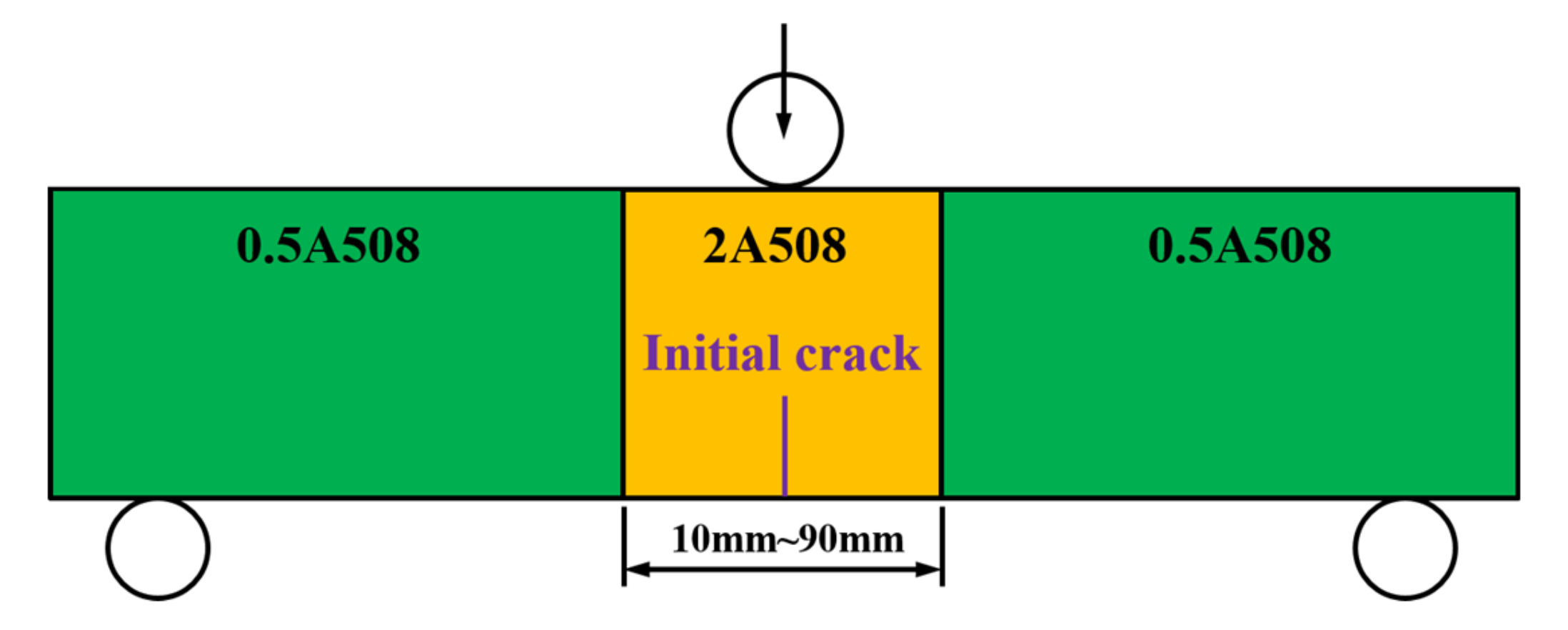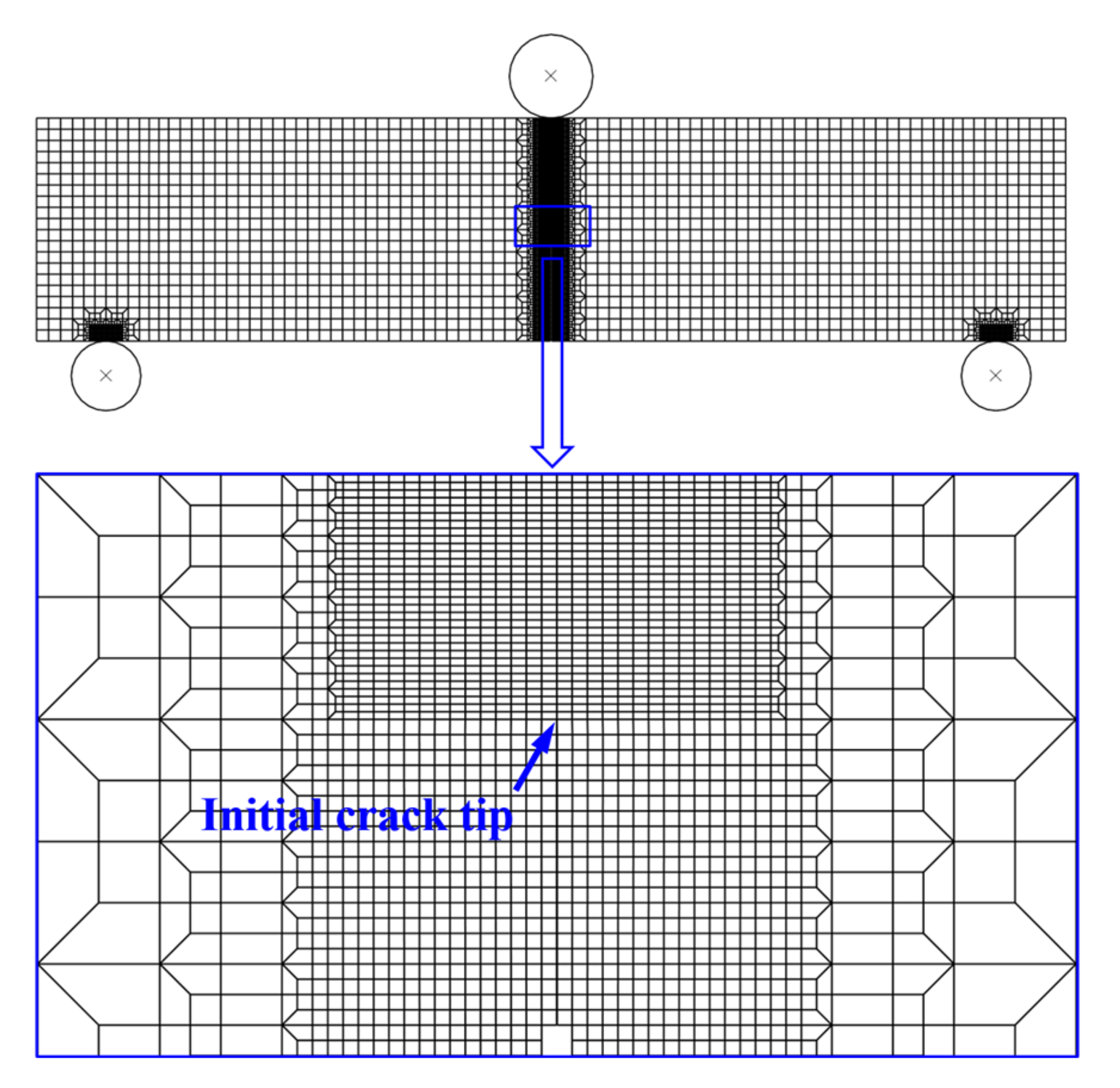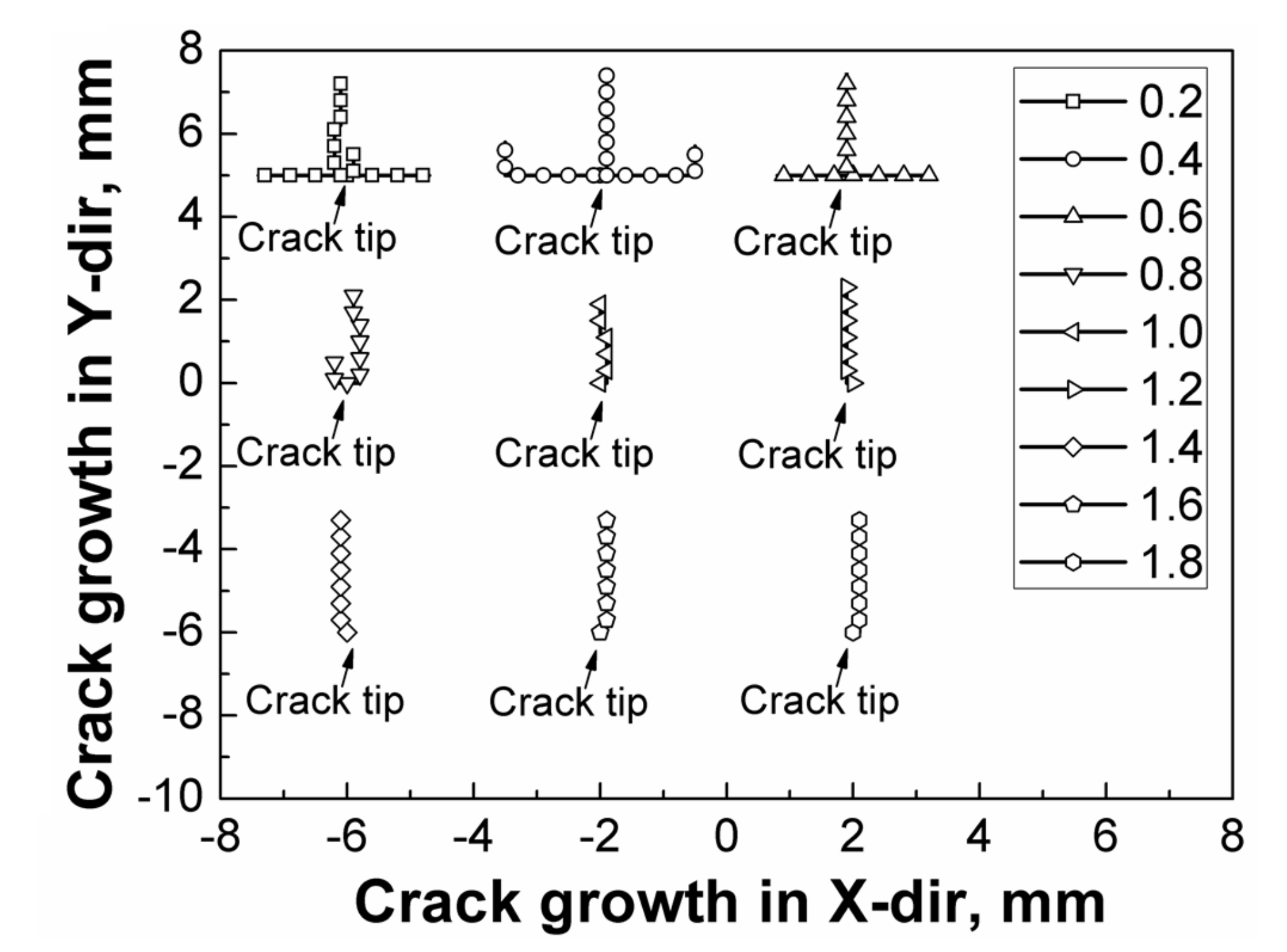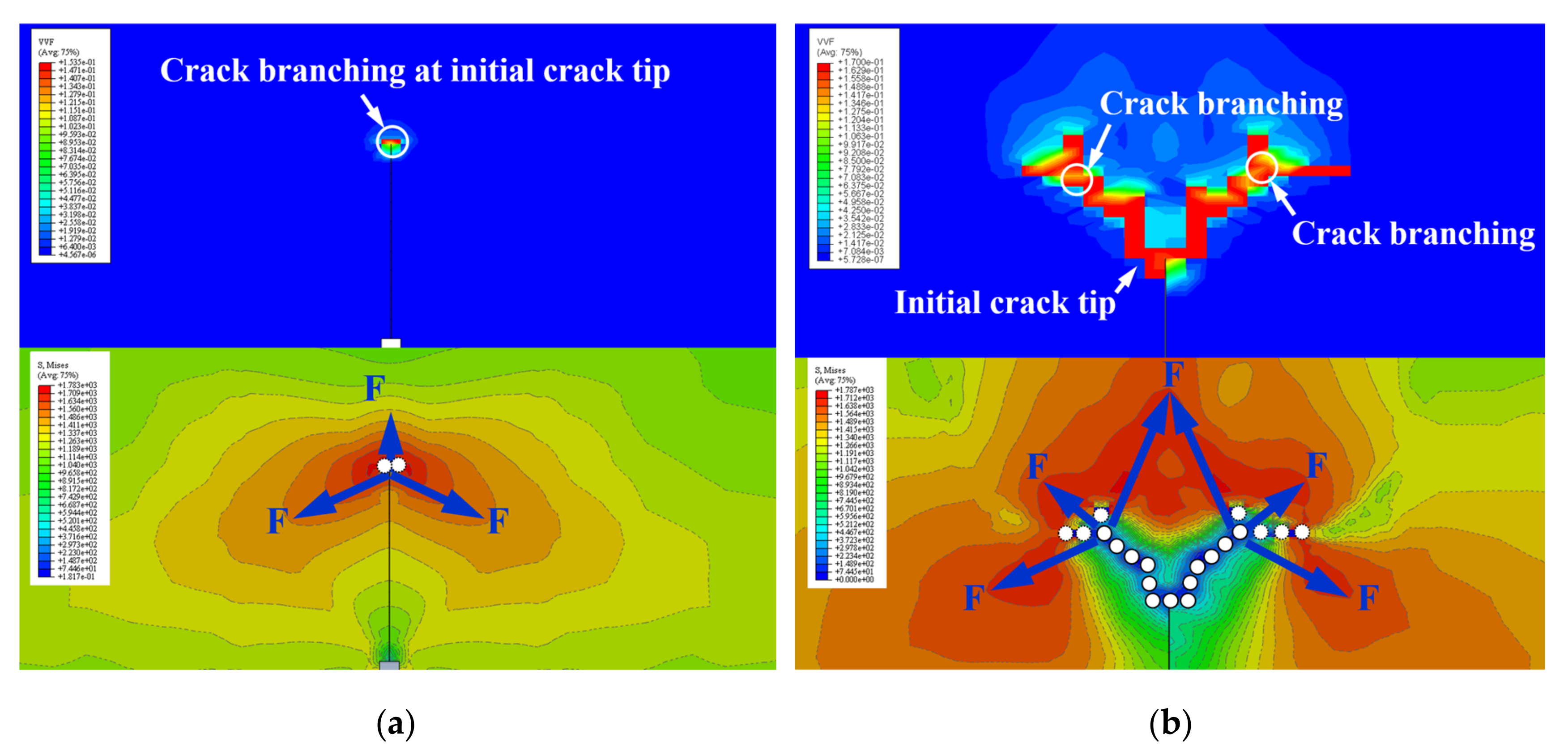Capturing and Micromechanical Analysis of the Crack-Branching Behavior in Welded Joints
Abstract
1. Introduction
2. The Designed Crack-Branching Model
2.1. The First Crack-Branching Model
2.2. The Second Crack-Branching Model
2.3. The Third Crack-Branching Model
3. Finite Element Numerical Calculation
4. Verification of the Gurson-Tvergaard-Needleman Damage Model by Experimental Results
5. Results and Discussion
5.1. The First Crack-Branching Model
5.2. The Second Crack-Branching Model
5.3. The Third Crack-Branching Model
5.4. Crack-Branching Mechanism
6. Conclusions
- (1)
- With gradual increasing of the strength mismatch, crack-branching behavior becomes more apparent. Not just the quantity of the branches increases, the branch can even grow along with the direction perpendicular to the initial crack.
- (2)
- The similar strength mismatch on each side of the crack is a sufficient but not necessary condition for crack branching. As long as there is another large enough propagation trend that is different from the original crack propagation direction, crack-branching behavior occurs. A high strength mismatch that is induced by both the mechanical properties and dimensions of different regions is the key of crack branching in welded joints.
- (3)
- Each crack branching is accompanied by three local high stress concentrations at the crack tip. Three pulling forces that are created by the three local high stress concentrations pull the crack propagation along with the directions of stress concentrations. Under the combined action of the three pulling forces, crack branching occurs, and two new cracks initiate from the middle of the pulling forces.
- (4)
- The finite element method based on the GTN damage model is an effective method to simulate the crack-branching behavior in welded joints during the crack propagation process.
Supplementary Materials
Author Contributions
Funding
Acknowledgments
Conflicts of Interest
References
- Cox, B.N.; Gao, H.; Gross, D.; Rittel, D. Modern topics and challenges in dynamic fracture. J. Mech. Phys. Solids 2005, 53, 565–596. [Google Scholar] [CrossRef]
- Bouchbinder, E.; Fineberg, J.; Marder, M. Dynamics of simple cracks. Annu. Rev. Condens. Matter Phys. 2010, 1, 371–395. [Google Scholar] [CrossRef]
- Forquin, P. An optical correlation technique for characterizing the crack velocity in concrete. Eur. Phys. J. Spec. Top. 2012, 206, 89–95. [Google Scholar] [CrossRef]
- Curbach, M.; Eibl, J. Crack velocity in concrete. Eng. Fract. Mech. 1990, 35, 321–326. [Google Scholar] [CrossRef]
- Ožbolt, J.; Sharma, A.; Reinhardt, H.W. Dynamic fracture of concrete-compact tension specimen. Int. J. Solids Struct. 2011, 48, 1534–1543. [Google Scholar] [CrossRef]
- Ožbolt, J.; Bošnjak, J.; Sola, E. Dynamic fracture of concrete compact tension specimen: Experimental and numerical study. Int. J. Solids Struct. 2013, 50, 4270–4278. [Google Scholar] [CrossRef]
- Ožbolt, J.; Bede, N.; Sharma, A.; Mayer, U. Dynamic fracture of concrete L-specimen: Experimental and numerical study. Eng. Fract. Mech. 2015, 148, 27–41. [Google Scholar] [CrossRef]
- Zhang, Q.B.; Zhao, J. A review of dynamic experimental techniques and mechanical behaviour of rock materials. Rock Mech. 2014, 47, 1411–1478. [Google Scholar] [CrossRef]
- Mecholsky, J.J., Jr.; DeLellis, D.P.; Mecholsky, N.A. Relationship between fractography, fractal analysis and crack branching. J. Eur. Ceram. Soc. 2020, 40, 4722–4726. [Google Scholar] [CrossRef]
- Nakamura, N.; Kawabata, T.; Takashima, Y.; Yanagimoto, F. Effect of the stress field on crack branching in brittle material. Theor. Appl. Fract. Mech. 2020, 128, 102583. [Google Scholar] [CrossRef]
- Chen, Z.; Ju, J.W.; Su, G.; Huang, X.; Li, S.; Zhai, L. Influence of micro-modulus functions on peridynamics simulation of crack propagation and branching in brittle materials. Eng. Fract. Mech. 2019, 216, 106498. [Google Scholar] [CrossRef]
- Kou, M.M.; Lian, Y.J.; Wang, Y.T. Numerical investigations on crack propagation and crack branching in brittle solids under dynamic loading using bond-particle model. Eng. Fract. Mech. 2019, 212, 41–56. [Google Scholar] [CrossRef]
- Li, J.; Xie, Y.J.; Zheng, X.Y.; Cai, Y.M. Underlying fracture trends and triggering on Mode-II crack branching and kinking for quasi-brittle solids. Eng. Fract. Mech. 2019, 211, 382–400. [Google Scholar] [CrossRef]
- Bouchbinder, E.; Mathiesen, J.; Procaccia, I. Branching instabilities in rapid fracture: Dynamics and geometry. Phys. Rev. E 2005, 71, 056118. [Google Scholar] [CrossRef] [PubMed]
- Boué, T.G.; Cohen, G.; Fineberg, J. Origin of the microbranching instability in rapid cracks. Phys. Rev. Lett. 2015, 114, 054301. [Google Scholar] [CrossRef]
- Karma, A.; Lobkovsky, A.E. Unsteady crack motion and branching in a phase-field model of brittle fracture. Phys. Rev. Lett. 2004, 92, 245510. [Google Scholar] [CrossRef] [PubMed]
- Falk, M.L.; Needleman, A.; Rice, J.R. A critical evaluation of cohesive region models of dynamic fracture. J. Phys. IV 2001, 11, 43–50. [Google Scholar]
- Zhou, F.; Molinari, J.F.; Shioya, T. A rate-dependent cohesive model for simulating dynamic crack propagation in brittle materials. Eng. Fract. Mech. 2005, 72, 1383–1410. [Google Scholar] [CrossRef]
- Belytschko, T.; Chen, H.; Xu, J.; Zi, G. Dynamic crack propagation based on loss of hyperbolicity and a new discontinuous enrichment. Int. J. Numer. Meth. Eng. 2003, 58, 1873–1905. [Google Scholar] [CrossRef]
- Xu, D.; Liu, Z.; Liu, X.; Zeng, Q.; Zhuang, Z. Modeling of dynamic crack branching by enhanced extended finite element method. Comput. Mech. 2014, 54, 489–502. [Google Scholar] [CrossRef]
- Henry, H. Study of the branching instability using a phase field model of inplane crack propagation. EPL-Europhys. Lett. 2008, 83, 16004. [Google Scholar] [CrossRef]
- Bleyer, J.; Roux-Langlois, C.; Molinari, J.F. Dynamic crack propagation with a variational phase-field model: Limiting speed, crack branching and velocity-toughening mechanisms. Int. J. Fract. 2017, 204, 79–100. [Google Scholar] [CrossRef]
- Hofacker, M.; Miehe, C. Continuum phase field modeling of dynamic fracture: Variational principles and staggered FE implementation. Int. J. Fract. 2012, 178, 113–129. [Google Scholar] [CrossRef]
- Hofacker, M.; Miehe, C. A phase field model of dynamic fracture: Robust field updates for the analysis of complex crack patterns. Int. J. Numer. Meth. Eng. 2013, 93, 276–301. [Google Scholar] [CrossRef]
- Karma, A.; Kessler, D.A.; Levine, H. Phase-field model of mode III dynamic fracture. Phys. Rev. Lett. 2001, 87, 045501. [Google Scholar] [CrossRef] [PubMed]
- Henry, H.; Adda-Bedia, M. Fractographic aspects of crack branching instability using a phase-field model. Phys. Rev. E 2013, 88, 060401. [Google Scholar] [CrossRef]
- Bobaru, F.; Zhang, G. Why do cracks branch? A peridynamic investigation of dynamic brittle fracture. Int. J. Fract. 2015, 196, 59–98. [Google Scholar] [CrossRef]
- Lloberas-Valls, O.; Huespe, A.E.; Oliver, J.; Dias, I.F. Strain injection techniques in dynamic fracture modeling. Comput. Method Appl. Mech. 2016, 308, 499–534. [Google Scholar] [CrossRef]
- Linder, C.; Armero, F. Finite elements with embedded branching. Finite Elem. Anal. Des. 2009, 45, 280–293. [Google Scholar] [CrossRef]
- Geelen, R.J.M.; Liu, Y.; Dolbow, J.E.; Rodríguez-Ferran, A. An optimization-based phase-field method for continuous-discontinuous crack propagation. Int. J. Numer. Meth. Eng. 2018, 116, 1–20. [Google Scholar] [CrossRef]
- Wu, T.; Carpiuc-Prisacari, A.; Poncelet, M.; De Lorenzis, L. Phase-field simulation of interactive mixed-mode fracture tests on cement mortar with full-field displacement boundary conditions. Eng. Fract. Mech. 2019, 182, 658–688. [Google Scholar] [CrossRef]
- Yang, J.; Wang, G.Z.; Xuan, F.Z.; Tu, S.T.; Liu, C.J. An experimental investigation of in-plane constraint effect on local fracture resistance of a dissimilar metal welded joint. Mater. Des. 2014, 53, 611–619. [Google Scholar] [CrossRef]
- Yang, J.; Wang, G.Z.; Xuan, F.Z.; Tu, S.T.; Liu, C.J. Out-of-plane constraint effect on local fracture resistance of a dissimilar metal welded joint. Mater. Des. 2014, 55, 542–550. [Google Scholar] [CrossRef]
- Wang, H.T.; Wang, G.Z.; Xuan, F.Z.; Liu, C.J.; Tu, S.T. Local mechanical properties and microstructures of Alloy52M dissimilar metal welded joint between A508 ferritic steel and 316L stainless steel. Adv. Mater. Res. 2012, 509, 103–110. [Google Scholar] [CrossRef]
- Gurson, A.L. Continuum theory of ductile rupture by void nucleation and growth: Part I-Yield criteria and flow rules for porous ductile media. J. Eng. Mater. Technol. 1977, 99, 2–15. [Google Scholar] [CrossRef]
- Chu, C.C.; Needleman, A. Void nucleation effects in biaxially stretched sheets. J. Eng. Mater. Technol. 1980, 102, 249–256. [Google Scholar] [CrossRef]
- Tvergaard, V. Influence of voids on shear band instabilities under plane strain conditions. Int. J. Fract. 1981, 17, 389–407. [Google Scholar] [CrossRef]
- Tvergaard, V. On localization in ductile materials containing spherical voids. Int. J. Fract. 1982, 18, 157–169. [Google Scholar]
- Tvergaard, V.; Needleman, A. Analysis of the cup-cone fracture in a round tensile bar. Acta Metal. 1984, 32, 157–169. [Google Scholar] [CrossRef]
- Benseddiq, N.; Imad, A. A ductile fracture analysis using a local damage model. Int. J. Pres. Ves. Pip. 2008, 85, 219–227. [Google Scholar] [CrossRef]
- Yang, J.; Wang, G.Z.; Xuan, F.Z.; Tu, S.T. Unified characterisation of in-plane and out-of-plane constraint based on crack-tip equivalent plastic strain. Fatigue Fract. Eng. Mater. Struct. 2013, 36, 504–514. [Google Scholar] [CrossRef]
- Østby, E.; Thaulow, C.; Zhang, Z.L. Numerical simulations of specimen size and mismatch effects in ductile crack growth-Part I: Tearing resistance and crack growth paths. Eng. Fract. Mech. 2007, 74, 1770–1792. [Google Scholar] [CrossRef]
- Østby, E.; Thaulow, C.; Zhang, Z.L. Numerical simulations of specimen size and mismatch effects in ductile crack growth-Part II: Near-tip stress fields. Eng. Fract. Mech. 2007, 74, 1793–1809. [Google Scholar] [CrossRef]
- Yang, J. Micromechanical analysis of in-plane constraint effect on local fracture behavior of cracks in the weakest locations of dissimilar metal welded joint. Acta Metall. Sin. 2017, 30, 840–850. [Google Scholar] [CrossRef]
- Penuelas, I.; Betegon, C.; Rodriguez, C. A ductile failure model applied to the determination of the fracture toughness of welded joints. Numerical simulation and experimental validation. Eng. Fract. Mech. 2006, 73, 2756–2773. [Google Scholar] [CrossRef]
- Wang, H.T.; Wang, G.Z.; Xuan, F.Z.; Tu, S.T. An experimental investigation of local fracture resistance and crack growth paths in a dissimilar metal welded joint. Mater. Des. 2013, 44, 179–189. [Google Scholar] [CrossRef]
- Yang, J.; Wang, L. Effect Range of the Material Constraint—I. Center Crack. Materials 2019, 12, 67. [Google Scholar] [CrossRef]
- Dai, Y.; Yang, J.; Wang, L. Effect Range of the Material Constraint—II. Interface Crack. Metals 2019, 9, 696. [Google Scholar] [CrossRef]
- Dai, Y.; Yang, J.; Chen, H.F. Effect range of the material constraint in different strength mismatched laboratory specimens. Appl. Sci. 2020, 10, 2434. [Google Scholar] [CrossRef]













© 2020 by the authors. Licensee MDPI, Basel, Switzerland. This article is an open access article distributed under the terms and conditions of the Creative Commons Attribution (CC BY) license (http://creativecommons.org/licenses/by/4.0/).
Share and Cite
Wang, W.; Yang, J.; Chen, H.; Yang, Q. Capturing and Micromechanical Analysis of the Crack-Branching Behavior in Welded Joints. Metals 2020, 10, 1308. https://doi.org/10.3390/met10101308
Wang W, Yang J, Chen H, Yang Q. Capturing and Micromechanical Analysis of the Crack-Branching Behavior in Welded Joints. Metals. 2020; 10(10):1308. https://doi.org/10.3390/met10101308
Chicago/Turabian StyleWang, Wenjie, Jie Yang, Haofeng Chen, and Qianyu Yang. 2020. "Capturing and Micromechanical Analysis of the Crack-Branching Behavior in Welded Joints" Metals 10, no. 10: 1308. https://doi.org/10.3390/met10101308
APA StyleWang, W., Yang, J., Chen, H., & Yang, Q. (2020). Capturing and Micromechanical Analysis of the Crack-Branching Behavior in Welded Joints. Metals, 10(10), 1308. https://doi.org/10.3390/met10101308




